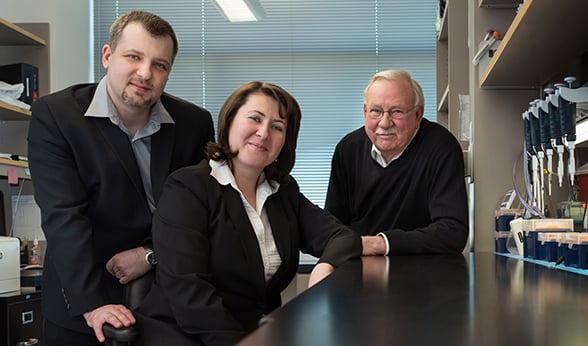A team of scientists from the University of Colorado School of Medicine and the Charles C. Gates Center for Regenerative Medicine at CU Anschutz has reported a more efficient approach to reprogramming a patient’s diseased skin cells into stem cells, raising hopes for future clinical trials and potential cures for critical illnesses.
The results were published on Feb. 21, 2018, in Nature Communications.
The team is reporting a clinically safe approach that consistently reprograms healthy and disease-associated patient’s skin cells into induced pluripotent stem cells (iPSCs) with an unprecedented efficiency.
 The research team includes, from left, Igor Kogut, PhD, Ganna Bilousova, PhD, and Dennis Roop, PhD.
The research team includes, from left, Igor Kogut, PhD, Ganna Bilousova, PhD, and Dennis Roop, PhD.Since its initial discovery in 2006 by Shinya Yamanaka, MD, PhD, iPSC reprogramming technology has created considerable interest in the field of regenerative medicine for its potential of providing an unlimited source of patient-specific cells suitable for transplantation. This technology involves the reprograming of adult skin cells taken from a donor into immature embryonic stem cell-like iPSCs. These iPSCs can be grown outside the body, genetically manipulated, converted into a variety of adult cell types and then either transplanted back to the same patient as an autograft or used as a platform for drug screening and research.
Despite significant advances, current methods for reprogramming adult cells into iPSCs are extremely inefficient and inconsistent, with less than 1 out of every 500-1000 adult human cells becoming iPSCs. The low efficiency of these protocols, coupled with the length of time in culture, increase the chances of accumulating harmful mutations in iPSCs, thus compromising the safety of this technology for clinical applications.
Addressing low reprogramming efficiency
To address the issue of low reprogramming efficiency, the team from the University of Colorado Anschutz Medical Campus optimized the cellular delivery of modified mRNAs, encoding several reprogramming factors in combination with microRNAs, and improved cell culturing conditions to enhance the growth of cells undergoing conversion into iPSCs.
“Many groups had previously attempted to improve reprogramming efficiency by identifying novel modulators of the process,” said Ganna Bilousova, PhD, an assistant professor of dermatology and one of the study’s lead scientists. “Instead of looking for new reprogramming enhancers, we took advantage of the versatility of RNA molecules to control the precise levels of reprogramming factors and microRNAs in cells during their conversion into iPSCs. We were surprised at how simple manipulations of the timing and dosing of the RNA molecules could affect the efficiency of reprogramming.”
The researchers showed that the fine-tuning of RNA delivery and cell culturing conditions dramatically enhanced the efficiency of reprogramming and improved the consistency of the process for disease-associated skin cells.
“Initiating reprogramming at a reduced cell density was critical for improving reprogramming efficiency in our study,” said Igor Kogut, PhD, an assistant professor of dermatology at the Gates Center. Kogut is also one of the paper’s lead authors. “There is a direct correlation between the rate of cell division and the efficiency of reprogramming. Our optimal, combinatorial RNA delivery regimen, which reduced the toxicity of the protocol, made it possible to initiate the process at a reduced cell density, down to individually-plated single cells.”
Shifting from lab to clinical trials
The goal now is to move the technology from the laboratory into clinical trials. Gates Center Director Dennis Roop, PhD, who is also one of the lead authors on the paper, recognizes the magnitude of the team’s work. He believes it holds great potential for the development of new corrective stem cell-based therapies for currently incurable diseases, such as Epidermolysis Bullosa (EB). Roop has had a long-standing interest in finding a permanent cure for EB, a group of inherited skin diseases that results in severe blistering and scarring. EB affects thousands of people across the United States and worldwide, and is characterized by chronic skin wounds similar in property to thermal burns, and indistinguishable from burns induced by chemical agents such as mustard gas.
“There are no effective therapies for EB, and iPSC technology provides an opportunity to develop a permanent corrective stem cell-based therapy for these severe skin-blistering diseases,” said Roop. “Our breakthrough in developing a highly-efficient reprogramming method, that avoids the use of viral vectors, may allow us to get FDA approval for one of the first iPSC-based clinical trials in the U.S.."
To accelerate getting iPSC-based therapies for EB into the clinic, the CU Anschutz team has established a consortium comprised of the University of Colorado, Stanford University (Anthony Oro, MD, PhD) and Columbia University (Angela Christiano, PhD).
The “EB iPS Cell Consortium” was initially supported by the EB Research Partnership (EBRP), the EB Medical Research Foundation, and the SOHANA Research Fund. More recently, the Consortium has received funding from the National Institute of Arthritis and Musculoskeletal and Skin Diseases through the 21st Century Cures Act for the Regenerative Medicine Innovation Project, and the California Institute for Regenerative Medicine’s Partnering Opportunity for Translational Research Projects. The research teams at both Stanford and Columbia have adopted the University of Colorado’s reprogramming technology as the method of choice for generating patient-specific iPSCs for future clinical trials, and thus are setting the standards for future iPSC-based therapies for other diseases.
Prior to receiving the above sources of funding for the Consortium, this study was supported by additional funding from the National Institute of Arthritis and Musculoskeletal and Skin Diseases, the US Department of Defense, the Foundation for Ichthyosis & Related Skin Types, the Dystrophic Epidermolysis Bullosa Research Association (DEBRA) International, The King Baudouin Foundation’s Vlinderkindje Fund, the Linda Crnic Institute for Down Syndrome, the Gates Frontiers Fund and private donors.
Guest contributors: Ganna Bilousova, Michael Booth and Jill Cowperthwaite contributed to this article.




